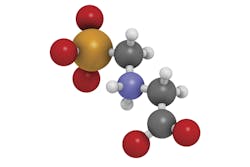What is it?
- Glyphosate, also known as Roundup and by several other trade names, is a broad spectrum herbicide that was introduced by Monsanto in 1974.
- The post-emergent systemic herbicide kills or suppresses virtually all plant types including weeds, grasses, shrubs and trees, and also has some aquatic plant control applications.
- Its chemical name is N-(phos-phonomethyl)glycine, and it is a fairly simple phosphonate with the chemical formula C3H8NO5P.
- It is marketed in several salt forms in water solution along with inert ingredients that facilitate plant uptake.
- Its original patents ran out in 1991 and 2000, so today it has many producers.
- It is probably the most widely used agricultural herbicide for residential lawns, and it is registered in at least 130 countries. Annual world production is more than 720,000 metric tons.
Occurrence
- Glyphosate is biodegradable by soil microbes. The major metabolites are aminomethylphosphonic acid (AMPA) and carbon dioxide. AMPA is more persistent than glyphosate.
- Glyphosate was detected in 36 percent of the stream samples, with a maximum of 8.7 micrograms per liter (µg/L) and a median less than 0.1 µg/L, by a 2002 U.S. Geological Survey study in nine Midwestern states. AMPA was detected in 69 percent of the samples with a maximum of 3.6 µg/l.
- Glyphosate has usually been detected in a small percentage of cereals, fruit and vegetable samples.
- Glyphosate is a potent herbicide. The weed control application rate is only about 3 to 4 pounds per hectare (about 2.5 acres or 10,000 square meters).
- Some weeds are developing resistance to glyphosate, which is nature’s way of compensating for a toxic stress.
- Genetically modified, glyphosate-resistant transgenic corn; cotton; canola; and soybean varieties have been developed and are widely planted, allowing concurrent glyphosate applications for weed control.
Health effects
- Numerous regulators and advisory panels worldwide have reviewed the toxicology of glyphosate and concluded that it has low toxicity to humans and does not pose a cancer risk.
- However, a recent review by the International Agency for Research on Cancer created controversy by concluding from essentially the same database that it is probably carcinogenic to humans based on limited evidence of cancer risk in humans and sufficient evidence in experimental animals.
- A few epidemiological studies provided mixed results primarily in the highest exposure groups, and some were non-statistically significant for lymphocytic leukemia or non-Hodgkin lymphoma.
- Several high-dose carcinogenicity studies in mice produced small differences between the zero controls and lower doses, and the highest dose. High-dose rat studies were negative. If it is carcinogenic in mice, the potency is probably very low.
Analysis
- Water analyses often involve derivatization and gas chromatography, but the limited occurrence potential and high drinking water maximum contaminant level (MCL) and maximum contaminant level goal (MCLG) do not generally warrant analyses.
Water treatment
- Chlorination, ozonation, advanced oxidation processes, nanofiltration and reverse osmosis can generally provide good removal of glyphosate.
- Biodegradation and adsorption processes can be effective for removing glyphosate in bank filtration and slow sand filters.
- Granular activated carbon treatment is also effective.
Regulation
- The U.S. Environmental Protection Agency’s MCLG and MCL for glyphosate are 700 µg/L.
- The World Health Organization concluded that drinking water guideline values for glyphosate and AMPA are not necessary because of the low risk to drinking water.
Dr. Joe Cotruvo is president of Joseph Cotruvo and Associates, LLC, Water, Environment and Public Health Consultants and technical editor of Water Technology. He is a former director of the EPA Drinking Water Standards Division.


